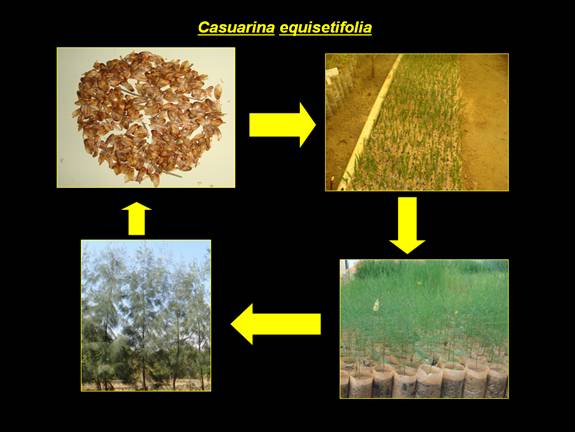
|
|
| Home | About Forestry | Eco-Tourism | Forestry Addresses | FAQs | Contact Us | |
|
| Industrial Forestry | |
PULPWOOD SPECIESCasuarina equisetifolia
Scientific name: Casuarina equisetifolia
Distribution: In Tamil Nadu, this tree is mainly grown in districts of Cuddalore, Villupuram, Kancheepuram,Tiruvallur Thanjavur and Ramanathapuram. It could also be seen on sandy soils of inland districts. Rotation: The rotation age is 4 years under irrigated condition. Spacing: Depending upon the end use spacing varies. Poles 1 m x 1 m, Fuel wood 0.5 m x 0.5 m, Pulp 2 m x 2 m, Agri-silviculture 4 m x 1 m.
Soil: The tree is best suited to light soils. This species tolerates calcareous and slightly saline soils, but it is grown poorly on heavy soils such as clays. It can withstand partial water logging for a long time. Seedlings produced in the nursery are outplanted after 6 months. Nursery technology: Seeds require no pretreatment. Dewinging is done because presence of wings affects germination. Crushing of seeds in between hands is done to remove wings. Seeds are sown in sunken beds @ 10-15 g per square meter. The seeds are mixed with an equal amount of sand and spread over the raised beds of 2m length, width of 1 m and depth of 22.5 cm and covered with nursery soil or sand (up to 7 cm). The bed is covered or mulched with dry grass or paddy straw or coir waste, to prevent the washing of seeds and to protect the germinated seedlings. The nursery bed needs to be kept moist by watering twice daily. Insecticide has to be applied to prevent ants/termite attack and 2% copper fungicide must be applied. Vegetative propagation: Vegetative propagation by cuttings or springs is very easy for this species. In India, cuttings are made from small branch lets (2 mm in diameter and 10-15 cm long) and rooting is enhanced with hormones IBA or IAA. In southern China, cuttings are taken from branch lets (1mm in diameter and 5 cm long) and soaked in a solution of NAA before being placed in polythene tubes. Planting techniques: Site preparation: Since this tree is a light demander, the area should be cleared of its Pitting and planting: Pits of 30 cm3 are prepared and seedlings are planted. Planting of naked seedlings are done in coastal areas and container seedlings in inland. Planting of two seedlings per pit at an espacement of 2 m x 2 m has given more basal area/unit area. Cultural practice: Weeding and Soil working: not necessary in sandy soils. In heavy soils, weeding and soil working is essential. Watering: Particularly in sandy tract, watering is essential till the onset of monsoon. In Application of manure: Added fertilizer boosts up growth immediately in sandy tract, Pruning: At the end of 2nd year or after beginning of third year pruning is essential. Thinning: This is done to get large sized and straight poles Harvest: The trees are felled after the required period and the stumps are uprooted. Intercropping: Pulses can be raised as intercrops in the inter space of tree rows (i.e. Yield: Coastal area at 2 m x 2 m - 80 to 100 t/ha in 8 years. 1 m x 1 m spacing at Uses: The wood is main raw material for pulpwood industry. It also used in erosion control, coastal afforestation, Tsunami restoration in coastal lengths, ornamental, shade/shelter, fuel wood, fiber. |
|
| Home | About Forestry | Eco-Tourism | Forestry Addresses | FAQs | Disclaimer | Contact Us | |
|
| © All Rights Reserved. TNAU-2016. |
|
